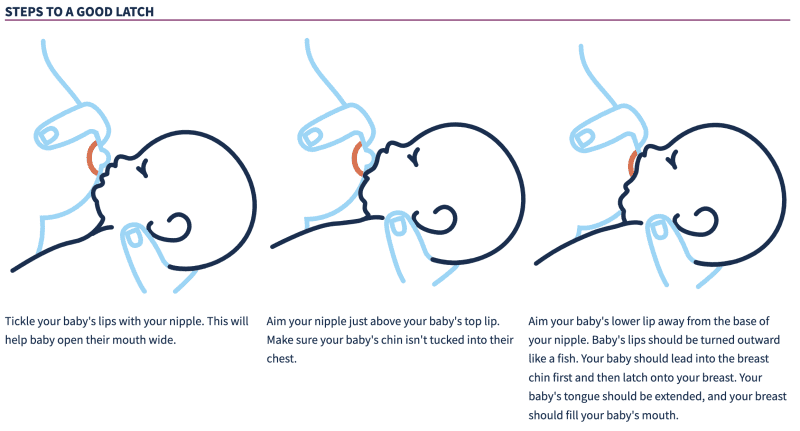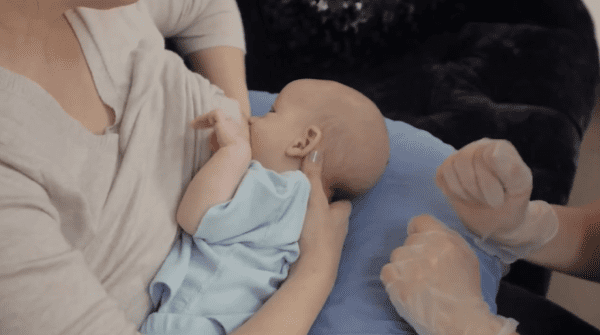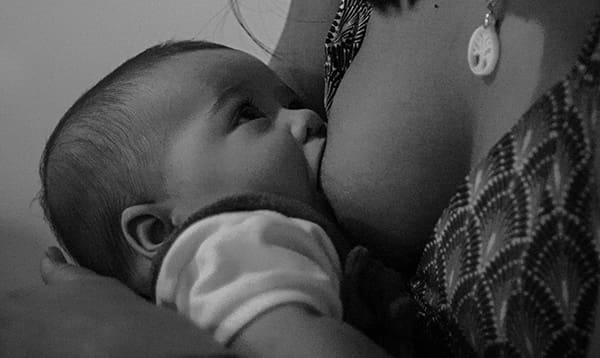By Ali Weatherford
The quest for a good latch or breastfeeding position are probably what encourage most people to visit with a lactation consultant or counselor. These are really important things to consider! The baby’s latch and how you position your baby might work right at first even if they’re not quite right, but over time, problems here can lead to bigger issues.
What is THE BREASTFEEDING LATCH?
Latch just refers to how the baby puts the nipple and breast into their mouth. Some things to notice include:
- How far does the nipple go in?
- How much breast tissue goes in?
- Can you still see areola? How much?
- What do the baby’s lips look like once they’re sucking?
- How does it feel to you?
- Are you hearing any strange noises? A clicking sound?
- Is the baby biting down or chomping at the nipple?
- Does it look like your baby’s lip is tucked under or splayed out?
A good latch is when all of the nipple and most or all of the areola is in the baby’s mouth. There should be enough breast tissue in there to really fill up the baby’s mouth. The milk ducts are not in the nipple. They are further back in the breast, so to get milk out, the baby needs to pull from beyond the nipple. A good latch means:
- You probably won’t see much of your areola.
- Your baby’s lips will splay out so they look like they’re making fish lips.
- It should be mostly quiet, or you’ll hear your baby breathing and swallowing.
- The baby’s chin touches the breast.


Diagram courtesy of WIC Breastfeeding Support
If you’re noticing that your baby’s latch doesn’t look like this, or if you’re having other problems on the list below, you should definitely see a lactation consultant. They can usually help you make adjustments that will solve the problem.
- Pain that lasts for more than a few seconds right at the beginning
- Nipples that don’t look like the normal shape after a feeding
- Baby is not gaining weight
- Baby is not making enough wet and dirty diapers
- Baby does not seem to be draining the breast
Breastfeeding Positions
The way you hold or “position” the baby for breastfeeding can have a big impact on how things feel as well. There is not just one right way to hold your baby. It’s important to find something that works for both of you. There are some basic guidelines to watch for so that things are lined up well for making a good latch though. If you’re comfortable, and your baby is content and has a good latch, it’s a good position! Here are some to try:
- Laid back breastfeeding: This means that you are reclined or semi-reclined and comfortable and your baby is sort of doing a face plant onto the breast. This allows the baby to control the latch a little bit better and has shown to result in a better latch and less nipple pain. It can also help if you have a strong milk flow by letting the baby control it better.

Laid back Position
- Cross-cradle hold: This position is great especially when you’re first starting out. It can give you a lot more control over the baby’s position and the shaping of your breast to help the baby get the right latch. It definitely requires you to use both hands and usually some support with cushions or pillows so you can be comfortable in this position for longer periods of time. One hand supports the baby’s neck and head and the other holds the breast.

Cross-cradle hold position
- Football hold: This can be a great position for your comfort, to help the baby with latch if you’re struggling in other positions, if you are recovering from a cesarean birth, or if you’re trying to breastfeed two babies at the same time! It’s very similar to the cross cradle hold, but instead of having your baby across the front of your body, they are shifted to your side.

Football hold position
- Cradle hold: This is the stereotypical breastfeeding position. Most of the time, this is how people imagine holding their baby for breastfeeding. This will likely work just fine, and become a go-to position, even if it’s not what you need right at the beginning. Your baby’s head rests in the crook of your elbow and your other arm either cradles the baby from underneath or goes wherever you need it to be! Especially if you use a pillow to prop up your arm, it can be very comfortable and leave your other hand free. You don’t have as much control over the baby’s head in this position as you do in the cross-cradle position, and it’s harder to hold the breast if you need to help the baby get a good latch. Once you and your baby get the hang of breastfeeding though, this will probably be a favorite position.

Cradle hold position
- Side-lying: This position is great for getting some rest. It’s also helpful if you had a cesarean birth and need to avoid having any pressure on your incision site.

Side-lying position
However you hold your baby for breastfeeding, it is important that you are comfortable. I definitely tolerated some VERY uncomfortable positions because I was afraid we would lose a good latch. Set yourself up well, because when you start in a comfortable position, you’re more likely to be able to stay as long as your baby needs without breaking a good latch.
And make sure your baby has a good latch EVERY TIME! A bad latch can cause pain and lead to nipple damage and other problems that can be harder to cope with. Getting it right every time also means the baby will learn the good latch more quickly, and over time, you won’t even need to correct a bad latch anymore. A lot of people have issues with latch or positioning which eventually discourages them from breastfeeding at all. You might think that breastfeeding is just uncomfortable and decide you don’t want to do it. It definitely does not have to be that way, so get help if you need it, but be comfortable!
Reference
https://wicbreastfeeding.fns.usda.gov/steps-and-signs-good-latch

